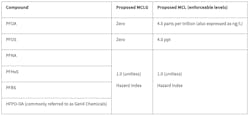EPA proposes MCLs for six PFAS in drinking water
The U.S. EPA announced that it is proposing enforceable Maximum Contaminant Levels (MCLs) and non-enforceable Maximum Contaminant Level Goals (MCLGs) for six per- and polyfluoroalkyl substances (PFAS).
EPA Administrator Michael Regan made the announcement in Wilmington North Carolina at 10:00 a.m. EST on Tuesday, March 14, 2023. EPA also livestreamed the announcement on YouTube.
“EPA is proposing the first-ever national standard to protect communities from PFAS in drinking water,” said Regan during the announcement. “This is something that communities like Wilmington have been demanding for years, and today we are finally answering those calls.
The proposal would establish National Primary Drinking Water Regulation (NPDWR) for the following PFAS compounds: perfluorooctanoic acid (PFOA), perfluorooctane sulfonic acid (PFOS), perfluorononanoic acid (PFNA), perfluorohexane sulfonic acid (PFHxS), perfluorobutane sulfonic acid (PFBS), and hexafluoropropylene oxide dimer acid (HFPO-DA, also known as GenX Chemicals).
The MCLs for PFOA and PFOS are very small, measuring only 4 parts per trillion (ppt). The ability to comply with such stringent levels can be challenging, from analysis to treatment. Thankfully, processes to measure and treat many PFAS to the ppt scale are already in operation today.
The MCL for the other four PFAS compounds would use the Hazard Index approach, requiring contaminants to be below 1.0 on the Hazard Index. The Hazard Index measures the extent that contaminant compares to its Health-Based Water Concentration, which is the level at which no health effects are expected. Under this approach, any combined concentration of the four compounds greater than 1.0 on the Hazard Index would exceed the MCL.
"The proposed regulation also requires compliance with a new 'Hazard Index' (HI) for four additional PFAS (PFNA, PFHxS, PFBS, and GenX)," said Mark White, drinking water practice leader for CDM Smith. "The HI, a new regulatory concept for many utilities, is a unitless calculated value that considers the aggregate of the measured levels of these four PFAS in drinking water relative to their respective Health Advisory Levels (HALs). It is anticipated that the new PFAS MCLs and HI will greatly impact the number of water systems that will be required to implement treatment technologies to address PFAS.”
EPA has stated that it plans to provide water systems with a web-based form that would automatically calculate the Hazard Index for the four substances' combined concentrations in drinking water.
"The combination of numerical limits (PFOA/PFOS) and the hazard index approach seems appropriate for PFAS as a family of compounds, given the complexity and variability of toxicity and treatment of the PFAS compounds," said Sean Lammerts, director of emerging contaminant services at Black & Veatch.
The MCLs and MCLGs for each compound are available on EPA's website in a table as follows:
“When finalized, this proposed regulation will require public water systems to monitor these chemicals. It will also require systems to notify the public and reduce levels of these PFAS as prescribes,” said Regan. “This is a tremendous step forward in the right direction. We anticipate that, when fully implemented, this rule will prevent thousands of deaths and tens of thousands of serious PFAS-related illnesses.”
The proposed rule would specifically require public water systems to: monitor for these six PFAS, notify the public of the levels of these PFAS, and reduce the levels of these PFAS in drinking water if they exceed the proposed MCLs.
The proposal is dense and deeply intricate. During the announcement, EPA provided 12 PDF documents describing different aspects of the proposal for each PFAS compound. In total, the documents provide over 4,013 pages of information.
The agency says that the proposal will follow its usual proposal approval process, with a window for receiving comments. The public comment period will open once the proposed rule is published on the Federal Register. Afterwards, comments can be provided at www.regulations.gov under the docket ID EPA-HQ-OW-2022-0114. EPA is providing 60 days for public comment.
Regan has stated the he expects EPA to finalize the rule by the end of 2023.
“We’re going to do what we always do, which is take comments and continue to engage the community and those who will respond to this proposal," said Regan. "By the end of this year, I plan to have this rule finalized so we can put it into action as soon as possible."
With EPA's growing involvement in PFAS regulation over the past few years, the cost of PFAS management has long been a concern for water systems. After Regan began to answer questions at the announcement event, one attendee asked the EPA administrator about financial support for public water systems.
“We have about $9 billion dedicated to prioritizing those water utilities and communities that are on the front lines and are resource-constrained the most. We recognize that that’s not enough for every single water utility in the country, but it’s a shot in the arm,” said Regan. “You’ll see that, as the president advocates for EPA’s new budget this year, he’s asking for more resources to continue to combat this pervasive issue.”
Response from water organizations
The announcement has already prompted statements from prominent organizations across the water sector. Generally, these organizations expressed support for PFAS regulation — but also expressed concern for the significant costs that would fall onto public water systems and their ratepayers.
AMWA
The Association of Metropolitan Water Agencies (AMWA) says that it is reviewing the proposed rule now.
"AMWA intends to provide EPA a robust set of comments to help strengthen the rule and ensure decisions are made with the best available science while taking costs into account, as required under the Safe Drinking Water Act," said Tom Dobbins, AMWA CEO.
Dobbins expressed concern about the cost that this rule could bring to drinking water utilities. The association says that EPA estimates the quantified capital and operations and management (O&M) costs for the rulemaking would be $772 million per year.
"For comparison, AMWA member Cape Fear Public Utility Authority's estimated capital cost for its treatment was $43 million, and its annual operating cost was $3-5 million," said AMWA in its comment. "If about 16 utilities of similar size to Cape Fear nationwide had to implement comparable treatment techniques, the total cost would exceed EPA's estimate."
"Ultimately, without more federal support for upgrading current treatment technologies, average Americans will have to pay the cost of further treatment through higher rates for their water," Dobbins said.
The association also stated that it will be requesting an extension to the 60-day public comment period, pointing out that EPA's Office of Management and Budget had needed five months to review the proposed rule.
ASDWA
The Association of State Drinking Water Administrators (ASDWA) stated that it supports EPA's proposed drinking water standard. The association will work to review the proposal and provide meaningful input to EPA.
ASDWA pointed out that cost, supply chain issues and workforce development could be significant challenges for the nation's water systems after the final rule.
The association says that the funding from the Bipartisan Infrastructure Law will not be able to cover the entirety of water systems' adjustments, and significant rate increases will likely be required for most of the systems impacted by the proposed MCLs. The supply chain is also not yet prepared to provide the advanced treatment systems and components necessary for PFAS management. Lastly, the proposed regulation will likely require an expansion of water operators employed by each system, and many current system operators will likely need to achieve higher levels of certifications at the cost of staff time and resources.
WEF
The Water Environment Federation (WEF) also voiced support for PFAS regulation, but expressed concerns about costs and other possible consequences.
"Putting forward regulations like this helps to ensure public health; that is the core mission of everyone in the water sector," said Walt Marlow, WEF's executive director, in a statement. "As a community, we have a responsibility to engage with this rulemaking procedure to ensure that all decisions are based on sound science and do not overlook unintended consequences that could come along with these limits."
The federation pointed out that EPA's estimated annual cost of $772 million is far below the estimates that other entities have found when analyzing the expected costs of PFAS drinking water regulations. These increased costs could fall onto ratepayer or divert funding from other important drinking water projects. WEF also stated that the regulation could affect water resource recovery facilities' effluent management, facilities that formally reuse their effluent, and other facilities that release effluent into waters that serve as drinking water sources downstream.
NGWA
The National Groundwater Association (NGWA) voiced support for the proposal, with plans to review the rule.
"We applaud the EPA on this historic action and look forward to hard work ahead of examining how this newly proposed standard can effectively provide clean and safe drinking water to all," said Terry S. Morse, NGWA CEO, in a statement.
AWWA
The American Water Works Association (AWWA) voiced similar support or regulation and concern for costs.
"AWWA appreciates EPA’s progress on this rulemaking as states, water systems, and consumers have been waiting for a clear and consistent path forward to address PFAS," said the association in its statement responding to the proposal.
AWWA also noted that a recent study, conducted by Black & Veatch on behalf of AWWA, had estimated the national cost for drinking water treatment installment to remove PFOA and PFOS to exceed $3.8 billion annually. This cost would likely be borne by communities and ratepayers, and would compete with other water systems needs like resiliency, aging infrastructure, and cybersecurity.
"The 2021 Bipartisan Infrastructure Law provides increased federal water infrastructure investment, but the costs of meeting the proposed standards will far exceed the additional funding," said AWWA in the statement.
Major period for PFAS regulation
The proposed rule is another milestone for a period of major changes to the regulatory landscape of PFAS and drinking water.
In 2022, EPA published a new testing method for PFAS in water at the part per billion level; issued Clean Water Act aquatic life criteria for PFOA and PFOS; added five PFAS chemicals to its list of regional screening and removal management levels; released drinking water health advisories for four PFAS chemicals; and proposed designating PFOA and PFOS as hazardous substances.
In that same year, the House of Representatives passed a bill that required EPA to quickly publish water quality criteria for PFAS and included several amendments aimed at limiting PFAS contamination.
In February 2023, EPA announced $2 billion was available for emerging contaminants in drinking water, placing special emphasis on addressing PFAS with the funds.








